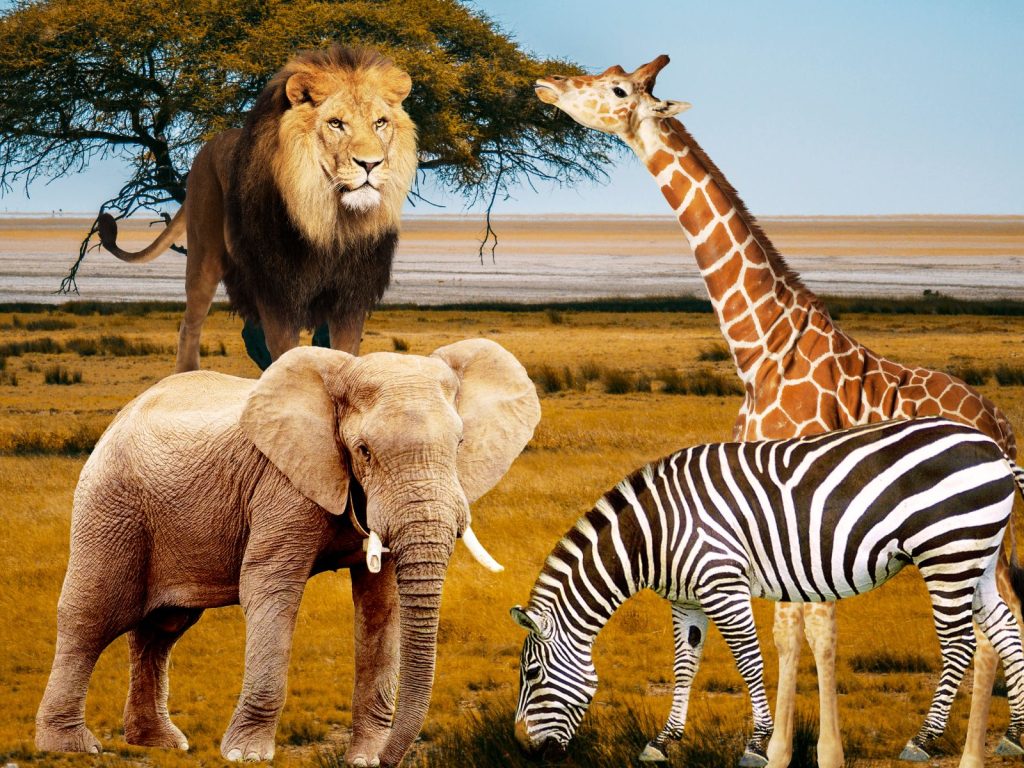1. Ecosystems and Biomes
South Africa’s biodiversity is largely shaped by its unique range of ecosystems and biomes. Wild Life in South Africa include:

1.1. Savanna
The savanna biome, characterized by a mix of grasslands and scattered trees, is home to many iconic African species. This biome includes the famous Kruger National Park, one of the largest game reserves in Africa. The savanna is inhabited by species such as:
- Elephants: The African elephant is the largest land animal and plays a crucial role in the ecosystem by modifying its habitat.
- Lions: Known as the “King of the Beasts,” lions are apex predators that help control the population of herbivores.
- Buffalo: The African buffalo is known for its strength and large herds, which can influence the structure of the savanna vegetation.
- Giraffes: With their long necks, giraffes feed on the leaves of tall trees, influencing plant growth patterns.
1.2. Fynbos
The fynbos biome is unique to the Cape Floral Kingdom and is characterized by its diverse and specialized plant species. It includes the Cape Winelands and parts of the Western Cape. Key species include:
- Proteas: These iconic flowering plants are adapted to the nutrient-poor soils of the fynbos.
- Cape Squirrel: Commonly seen in the fynbos, these squirrels are adapted to the area’s vegetation.
- Bontebok: A rare antelope species that has adapted to the fynbos environment.
1.3. Forests
Wild Life in South Africa’s forests, including those in the Knysna and Tsitsikamma regions, are rich in biodiversity. Forests provide habitat for species such as:
- Knysna Lourie: This colorful bird is found in the forests of the southern Cape.
- Bushbuck: A forest-dwelling antelope that is highly adaptable to dense vegetation.
- African Forest Elephant: Smaller than its savanna counterpart, this elephant subspecies prefers forested areas.
1.4. Desert and Semi-Desert
The Kalahari Desert and the Karoo are arid regions with unique adaptations. Species include:
- Kalahari Lion: Known for its adaptations to the harsh desert environment.
- Springbok: A small antelope that can survive in arid conditions.
- Meerkat: A social species that lives in complex burrow systems in the desert.
2. Notable Species
Wild Life in South Africa is home to a variety of remarkable species, both charismatic megafauna and lesser-known animals.
2.1. Big Five
The “Big Five” – lions, leopards, elephants, buffalo, and rhinoceroses – are among the most sought-after Wild Life in South Africa.
- Lions: Found in national parks like Kruger and Addo Elephant National Park.
- Leopards: Elusive and solitary, leopards are often spotted in dense bush.
- Elephants: Large herds roam in parks such as Kruger and Addo.
- Buffalo: Often seen in large herds, especially in Kruger.
- Rhinoceroses: Both white and black rhinos are critically endangered but can be seen in several reserves.
2.2. Unique Species
South Africa is also known for its unique and rare species:
- African Penguin: Also known as the Jackass Penguin, found along the Western Cape coast.
- Cape Vulture: A critically endangered vulture species that resides in the mountainous regions.
- Pangolin: One of the most trafficked mammals in the world, pangolins are critically endangered.
2.3. Marine Life
South Africa’s coastlines are rich in marine biodiversity:
- Great White Shark: Found around the coast of Gansbaai and False Bay.
- Southern Right Whale: Known for its impressive migrations to the South African coast for breeding.
- Humpback Whale: Seen migrating along the coast.
3. Conservation Efforts
South Africa has made significant strides in wildlife conservation, though challenges remain. Key efforts include:
3.1. Protected Areas
Wild Life in South Africa boasts numerous protected areas and national parks:
- Kruger National Park: One of Africa’s largest game reserves, known for its comprehensive conservation efforts.
- Addo Elephant National Park: A sanctuary for elephants and other wildlife.
- Table Mountain National Park: Protects the fynbos biome and is a UNESCO World Heritage Site.
3.2. Anti-Poaching Initiatives
Poaching, especially of rhinos and elephants, is a critical issue. South Africa has implemented various measures:
- Ranger Training: Specialized units are trained to combat poaching.
- Technology Use: Drones and other technologies are used to monitor and protect wildlife.
3.3. Community Involvement
Involving local communities in conservation efforts is crucial:
- Eco-Tourism: Provides economic incentives for communities to protect wildlife.
- Community Conservation Programs: Initiatives that engage local people in conservation efforts.
4. Challenges and Future Outlook
Despite significant efforts, South African wildlife faces several challenges:
4.1. Habitat Loss
Expansion of agriculture and urban areas threatens natural habitats. Conservationists work to balance development with habitat preservation.
4.2. Climate Change
Changes in climate patterns affect water availability and food resources for wildlife. Adaptation strategies are needed to mitigate these impacts.
4.3. Human-Wildlife Conflict
As human populations grow, conflicts between wildlife and people increase. Solutions include better management practices and community education.
4.4. Poaching and Illegal Trade
Poaching for ivory, horn, and bushmeat remains a significant threat. Continued efforts are necessary to address these illegal activities and their impacts on wildlife populations.
5. Conclusion
Wild Life in South Africa is a treasure trove of biodiversity, with each ecosystem supporting a rich array of species. From the majestic Big Five in the savannas to the unique flora of the fynbos, the country’s wildlife is a reflection of its diverse landscapes. While conservation efforts have made a positive impact, ongoing challenges require continued vigilance and innovation. By fostering sustainable practices and community involvement, South Africa aims to protect its wildlife for future generations, ensuring that its natural heritage endures.
